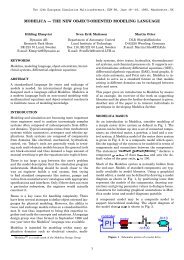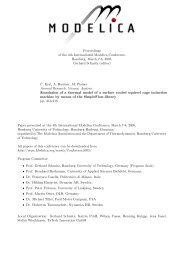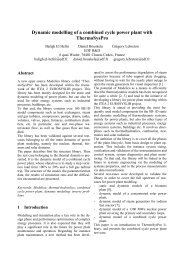Johan Andreasson Division of Vehicle Dynamics, Royal ... - CiteSeerX
Johan Andreasson Division of Vehicle Dynamics, Royal ... - CiteSeerX
Johan Andreasson Division of Vehicle Dynamics, Royal ... - CiteSeerX
You also want an ePaper? Increase the reach of your titles
YUMPU automatically turns print PDFs into web optimized ePapers that Google loves.
J. <strong>Andreasson</strong> <strong>Vehicle</strong><strong>Dynamics</strong> library<br />
<strong>of</strong> different suspensions or wheels. This is instead<br />
handled as described in Section 6, using the<br />
redeclare constructs in Modelica.<br />
Suspension level Common for all individual suspensions<br />
are the linkages that carry the wheels and<br />
normally there is some kind <strong>of</strong> roll-suppressing<br />
mechanism between these. If the suspension is<br />
steerable there is also a steering rack. Each <strong>of</strong><br />
theses components can be used to build up new<br />
suspensions. Thus, the suspension linkage, here a<br />
MacPherson, could easily be replaced by another<br />
linkage, e.g. a double wishbone or a multi-link.<br />
In the same manner, the steering and the anti roll<br />
linkages can also be replaced. Furthermore, all<br />
parameters are gathered in a data record, making<br />
it easy to change a whole suspension setup.<br />
The idea with the suspension level is to make it<br />
easy to reconfigure a car by just swapping suspension<br />
and therefore, all suspension models should<br />
share the same basic interface, i.e. one MBS-cut<br />
for the connection to the body. There should also<br />
be an MBS cut for each wheel (normally two) that<br />
is to be connected to the suspension. Additionally,<br />
there may be some extra connectors depending<br />
on the suspension. For example, a steerable<br />
suspension will also have a connector for a steering<br />
wheel.<br />
Component level Within the component level, the<br />
foundation for efficient reuse <strong>of</strong> vehicle models<br />
is laid. Components like a-arms, bushings, Mac<br />
Pherson struts, trailing arms, multi-links, anti roll<br />
linkages, rack steerings etc. are available. In<br />
this version, these components are based on the<br />
Modelica and ModelicaAdditions libraries.<br />
Other basic models that are needed in the component<br />
models, such as nonlinear spring-dampers,<br />
are described in Section 4.<br />
2.1 Parameterisation<br />
The parameterisation <strong>of</strong> the chassis is based on a Body<br />
Geometric Reference frame (BGR). This frame is orientied<br />
according to the DIN standard, the x, y and z<br />
axes point forward, left and upward respectively, see<br />
Figure 3.<br />
The geometry <strong>of</strong> the chassis and the suspensions<br />
are then defined by a set <strong>of</strong> points where joints and<br />
ground frame<br />
x<br />
BGR<br />
z<br />
y<br />
Figure 3: The vehicles motion is specified by how the<br />
BGR moves relative to the ground frame. From the<br />
BGR, locations <strong>of</strong> e.g. centre <strong>of</strong> mass and construction<br />
poins are defined.<br />
bushings are located. Additionally, the mass and inertia<br />
properties <strong>of</strong> the parts within the linkage can<br />
be defined. For a comprehensive parameterisation <strong>of</strong><br />
these properties, a systematic definition <strong>of</strong> the parameter<br />
names is necessary.<br />
The geometry is mainly defied by the connection<br />
joint locations, connection points. Additionally, the<br />
direction(s) <strong>of</strong> a joint’s degree(s) <strong>of</strong> freedom must be<br />
given if not defined by the connection joint points. The<br />
geometry parameters are defined as:<br />
[geometry parameter]<br />
=[property][connection] [wheel no]<br />
[connection]<br />
=[part 1][part 2]..[part n]<br />
While the mass and inertia properties are component<br />
specific and are thus named according to:<br />
[component parameter]<br />
=[property][part] [wheel no]<br />
Where [property] and [part] are defined according<br />
to Table 1.<br />
When there are more than one part <strong>of</strong> the same<br />
type, a number is added to the character. For example,<br />
if there are more than one link, as in a doublewishbone,<br />
they are numbered L1, L2, etc., starting at<br />
the front upper link. The wheels are numbered from<br />
front left towards right and rear. Some examples <strong>of</strong><br />
parameter names are give below:<br />
rCL1 2 Location <strong>of</strong> connection joint between chassis<br />
and link 1 at front right wheel.<br />
The Modelica Association Modelica 2003, November 3-4, 2003
















